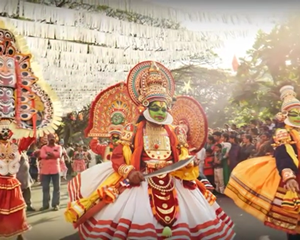Hey, there! I'm Mike Rugnetta. This is Crash Course Theatre,
嘿 大家好 我是迈克·鲁格内塔 这里是“戏剧速成课堂”
And today I'm gonna move my hands in very intricate in meaningful ways, as we discuss Kathakali,
今天 我的手要以一种非常复杂而又有意义的方式动起来 因为我们今天要讲的是“卡塔卡利舞剧”
the Indian dance drama that followed Sanskrit drama and is still being performed today.
一种继梵语戏剧之后的印度舞剧 至今仍有演出
Kathakali performances would last all night and climax at dawn with the killing of a demon, because after 8 hours you need a big finish.
“卡塔卡利舞剧”的演出会持续一整晚 在杀死恶魔之后进入到高潮 因为毕竟已经看了八个小时 结局必须震撼
Do you like colourful and frightening stage makeup? Then you have come to the right place. Eh, nice!
如果喜欢色彩鲜艳且恐怖的舞台妆 那么你来对地方了 呃 美!
By the 13th century, Sanskrit drama wasn't performed much anymore.
到了13世纪 梵语戏剧已经很少有演出
But some plays had been adapted for a form of dance worship called "Kutiyattam".
其中一些经过改编 融入了一种叫做“库提亚特姆”的敬拜舞蹈
Another form that absorbed Sanskrit drama is the "Krishnattam"—a cycle of eight dance dramas created around 1650
另外还有一种叫做“克里希纳坦”的舞蹈剧也吸收了梵语戏剧 这种舞蹈剧是献给“克利须那神”的 创作于1650年左右
and dedicated to the god Krishna, with one drama performed every night for eight consecutive nights.
由八部舞剧组成一个循环 每部舞剧要连续演出八晚
As religious works, Kutiyattam and Krishnattam were mostly performed in temples in the state of Kerala
因为是宗教产物 所以“库提亚特姆”和“克里希纳坦”一般都在喀拉拉邦的寺庙里进行表演
for any gods who happened to be watching, though high caste people were also allowed to attend.
为的是给碰巧路过的神观看 不过高种姓的人也有资格观看
That's a pretty small audience, so enter Kathakali.
因为观众比较少,所以就有了“卡塔卡利舞剧”
As with most ancient and early modern forms of drama, everyone say "with me, we don't know exactly when it began".
跟大多古时的和早期的现代戏剧形式一样 大伙儿都说:我根本不知道“卡塔卡利舞剧”啥前儿蹦出来的
But it was fully developed by the 17th century.
不过直到17世纪“卡塔卡利舞剧”才逐渐变得成熟
Historically, Kathakali was performed in the outer courtyards of temples.
过去 “卡塔卡利舞剧”的表演场地在寺庙外边儿的庭院里
So anyone could attend evening performances winter to spring.
所以任何人一年四季都可以过去观看甚至是夜间演出
Thousands showed up for popular works, like "Kutiyattam" and "Krishnattam",
热剧一上映 会有成千上万的人过来观看 比如“库提亚特姆”和“克里希纳坦”舞剧
Kathakali, whose name literally means "story play", is a fusion of music, dance and acting plus some awesome martial arts.
“卡塔卡利舞剧” 名字直译过来的话是“故事剧” 融合了音乐、舞蹈和表演 外加一些个酷炫的武术动作
Most Kathakali, like Sanskrit drama, borrows stories from the great Hindu epics—"the Mahabharata" and "the Ramayana".
和“梵语戏剧”一样 大部分的“卡塔卡利舞剧”也借用了伟大的印度教史诗《摩呵婆罗多》和《罗摩传》里面的故事
But some Kathakali plays borrow from other sacred texts, especially the Puranas.
不过 还有一些“卡塔卡利舞剧”借用了其它的圣言文本 特别是《印度史诗》
More recently, there have been caught Kathakali adaptations of Shakespeare and other Western dramas too.
最近还发现了莎士比亚以及其他一些西方戏剧作品的“卡塔卡利舞剧”改编版本
There's a repertoire of sixty plays still performed today.
其中有六十部保留剧目至今仍在演出

Most written in Malayalam, the most widely spoken language in Kerala. But there are portions in Sanskrit.
其中大部分是用“马拉雅拉姆语”撰写的 “马拉雅拉姆语”是“喀拉拉邦”地区使用最广泛的一种语言 不过也有梵语版
The plays typically were and still are performed by men. But some contemporary troupes include women.
“卡塔卡利舞剧”至今都是由男性表演 不过一些当代的剧团里面也会有女性演员
And honestly, underneath all that makeup and those fake demon breasts. How can you even tell?
说实话 化了妆再绑上恶魔的胸肌 根本分不清是男是女
The Kathakali stage is a square of ground in the temple courtyard with a satin curtain at the front, which represents worldly illusions.
“卡塔卡利舞剧”的舞台是寺庙庭院里的一个广场 舞台前挂有一块绸制幕布 代表世俗的幻象
And a brass lamp which welcomes divine the presence.
还有一盏迎接神人出现的铜灯
At dusk a drum invites the god to take their seats, and then two to three hours of preliminaries begin.
到了傍晚 鼓声响起邀请众神坐到自己的座位上 之后是两三个小时的预演
Prayers, warm-up acts, and drum solos before the eight hour performance.
也就是在长达八小时的正式演出开始之前 会有祷告、热身表演、鼓乐独奏这些预演项目
There are no set pieces except for a wooden stool. And there are no props except for weapons.
舞台布景只有一把木制凳子 道具也只有武器
The play usually ends at dawn, with the slaying of a demon or a demon king,
演出一般会在黎明时分结束 结束时会杀死一个恶魔或者恶魔老大
followed by a dance thanking the gods and asking for blessings on the audience. Then the lamp is extinguished.
之后会跳一段感谢神灵并祈求神灵保佑观众的舞蹈 之后灯灭
Contemporary audiences may not have the stamina for an all-night dance theater extravaganza that culminate demon-killing.
现在的观众可能没有时间精力去观看一场以杀死恶魔为高潮的通宵型舞剧
So these days performances lasts about three hours and usually includes scenes from three different place.
所以现在的“卡塔卡利舞剧”表演只有三个小时 包含三个不同的场景
In Kathakali there are three kinds of performers: actor dancers, percussionists, and singers.
“卡塔卡利舞剧”有三种演员:舞者演员、打击乐演奏者、还有歌手
Actors were once drawn from the ranks of martial artists.
演员以前都是从武术世家里选拔出来的
And would pledge to their patrons that they would perform until their dying day.
而且还要向他们的赞助人保证自己会一直演到死的那一天
Now things are a little less strict. still, you have to apprentice for 20 years to be considered a fully trained Kathakali performer.
不过现在没有那么严格 但还是需要在当了二十年的学徒之后才能成为一个被认可的接受过充分训练的“卡塔卡利舞剧”演员
Characters are typically based on archetypes: kings, heroines, demons, demonesses, Gods, animals, priests, though some seem drawn from life.
“卡塔卡利舞剧”里的角色通常基于原型:国王、女英雄、恶魔、女妖怪、神、动物、牧师 虽然有些看起来似乎来自现实生活
Actor dancers create their roles by learning highly regimented choreography. And I was not kidding: 500 distinct hand gestures called "Mudras".
舞者演员要通过学习高度严格的舞蹈编排来塑造自己的角色 而且我没有开玩笑:他们有五百种不同的手势 叫作“马德拉舞”
As none decays far as medieval treadeth a benign dark Panem says:
正如没有任何事物会随着中世纪的到来而消亡 帕纳姆说:
for wherever the hand moves, there the glances flows; where the glances go, the mind follows;
手在哪里移动,目光就在哪里流动;目光所到之处,心就往何处去;
where the mind goes, the mood follows; and where the mood goes, there is the flavor.
心往何处,情到何处;情到何处,何处就有了世事难料。
These gestures and a huge range of facial expressions allow them to tell the stories with just their bodies
大量的手势变换加上许许多多的面部表情使得演员们只需通过身体就能讲述故事
and reflect the inner state or bhava of each character. As we mentioned in Sanskrit drama, there are nine bhavas:
而且还能表现出每个人物的内心情感 也就是我们在梵语戏剧里提到的那九种“巴瓦”(情感)
The erotic, the comic, the pathetic, the angry, the heroic, the fearful, the repulsive, the wondrous, and peace.
色情的、滑稽的、悲哀的、愤怒的、英勇的、害怕的、令人厌恶的、令人惊奇的、平静的
Here is how to perform the "erotic bhava".
现在我为大家表演“色情巴瓦”
Open the upper lids as wide as possible. Keep the lower lids slightly closed.
上眼睑尽量打开 下眼睑轻微闭合
With the lips make a soft, relaxed smile but do not show the teeth.
嘴唇做出温柔、放松的微笑但不要露出牙齿
Keep the gaze focused straight ahead. having assumed this position, begin to flutter the eyebrows.
视线正对前方 摆出这个姿势之后开始抖动眉毛
Keeping the shoulders still, using the neck. Move the head first to the right and then to the left, back and forth.
肩膀不动脖子动 头部先向右、然后向左、这样来回动
Move the head to a 45-degree angle to the right, continuing to flutter the eyebrows, repeat to the left.
头部向右移动45度 继续抖眉毛 左边再来重复一遍


